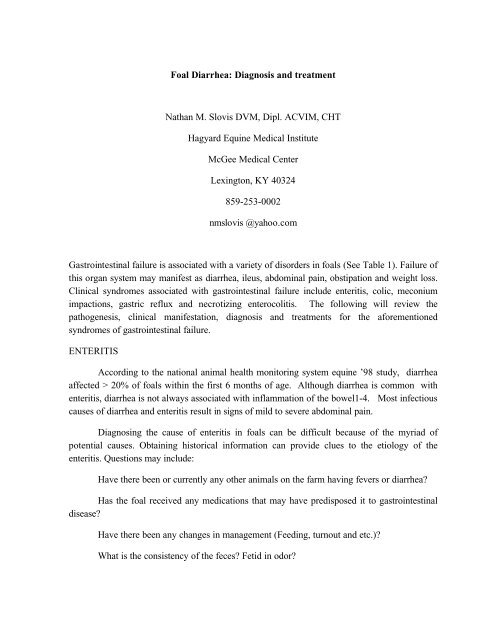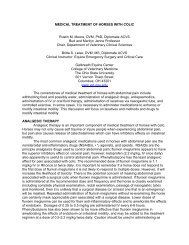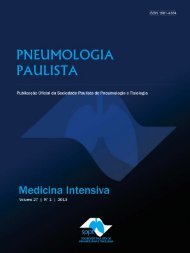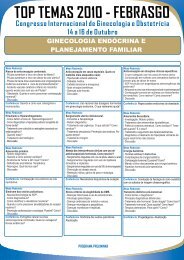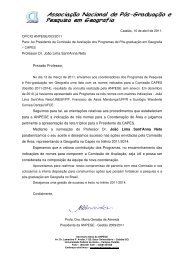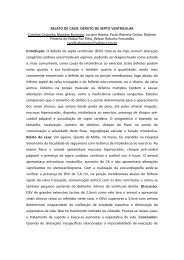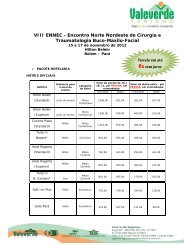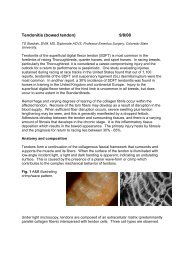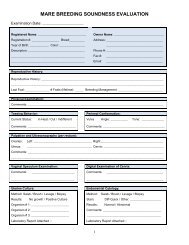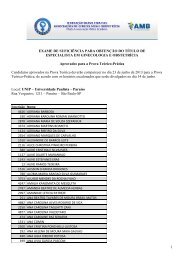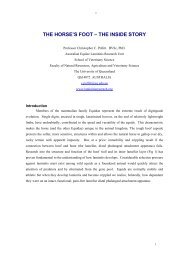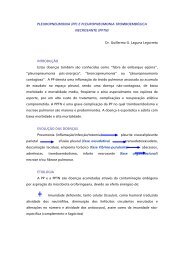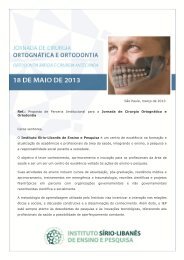Foal Diarrhea: Diagnosis and treatment Nathan M. Slovis DVM, Dipl ...
Foal Diarrhea: Diagnosis and treatment Nathan M. Slovis DVM, Dipl ...
Foal Diarrhea: Diagnosis and treatment Nathan M. Slovis DVM, Dipl ...
Create successful ePaper yourself
Turn your PDF publications into a flip-book with our unique Google optimized e-Paper software.
<strong>Foal</strong> <strong>Diarrhea</strong>: <strong>Diagnosis</strong> <strong>and</strong> <strong>treatment</strong><strong>Nathan</strong> M. <strong>Slovis</strong> <strong>DVM</strong>, <strong>Dipl</strong>. ACVIM, CHTHagyard Equine Medical InstituteMcGee Medical CenterLexington, KY 40324859-253-0002nmslovis @yahoo.comGastrointestinal failure is associated with a variety of disorders in foals (See Table 1). Failure ofthis organ system may manifest as diarrhea, ileus, abdominal pain, obstipation <strong>and</strong> weight loss.Clinical syndromes associated with gastrointestinal failure include enteritis, colic, meconiumimpactions, gastric reflux <strong>and</strong> necrotizing enterocolitis. The following will review thepathogenesis, clinical manifestation, diagnosis <strong>and</strong> <strong>treatment</strong>s for the aforementionedsyndromes of gastrointestinal failure.ENTERITISAccording to the national animal health monitoring system equine ’98 study, diarrheaaffected > 20% of foals within the first 6 months of age. Although diarrhea is common withenteritis, diarrhea is not always associated with inflammation of the bowel1-4. Most infectiouscauses of diarrhea <strong>and</strong> enteritis result in signs of mild to severe abdominal pain.Diagnosing the cause of enteritis in foals can be difficult because of the myriad ofpotential causes. Obtaining historical information can provide clues to the etiology of theenteritis. Questions may include:Have there been or currently any other animals on the farm having fevers or diarrhea?Has the foal received any medications that may have predisposed it to gastrointestinaldisease?Have there been any changes in management (Feeding, turnout <strong>and</strong> etc.)?What is the consistency of the feces? Fetid in odor?
What is the age of the foal?The most common life-threatening problem associated with enteritis is hypovolemic orseptic shock. Hypovolemic shock is characterized by pale mucus membranes, prolongedcapillary refill time <strong>and</strong> rapid weak pulses. Septic shock is commonly recognized by hyperemicmucus membranes, rapid capillary refill time <strong>and</strong> bounding/hyperdynamic pulses. The physicalparameters of shock vary as a continuum with the stage of shock. Aggressive fluid therapy isthe initial <strong>treatment</strong> for hypovolemic or septic shock. Blood samples should be obtained forpre<strong>treatment</strong> evaluation involving complete blood cell count (CBC), serum chemistry profile<strong>and</strong> ionized calcium. Lactate levels (Normal
<strong>Foal</strong>s are most susceptible to viral diarrheas during the neonatal, perinatal <strong>and</strong> sucklingperiods by virtue of being immunological naïve6. Clinical signs of disease have been reportedonly among foals < 6 months old <strong>and</strong> most often among foals < 3 months old.7 Signs includediarrhea, lethargy, anorexia <strong>and</strong> abdominal tympani. A 3-year study of horse farms in centralKentucky during the 80’s noted that rotavirus was the most common cause of diarrhea infoals.7 Rotavirus is species specific with an incubation period of 1-2 days. The virus invadesthe intestinal epithelium on the sides <strong>and</strong> the tips of the villi. The brush border epithelium ofthe small intestine synthesizes disaccharides to monosaccharides (glucose <strong>and</strong> galactose), whichare absorbed in the gut. Destruction of the brush border villi results in decreased lactaseformation, which results in lactose not being digested. This sugar remains in the lumen of thegut, osmotically attracting more fluid. This effect is compounded as bacteria in the largeintestine ferment the lactose into acetate, proprionate <strong>and</strong> butyrate, which increase osmolalityof the colonic contents. 8<strong>Foal</strong>s infected with rotavirus may shed the virus for up to 10 days.9,10 Some horses may shedthe virus for up to 8 months. The virus can persist in the environment for up to 9 months. 10<strong>Diagnosis</strong> requires detection of the virus in feces. The tests include electron microscopy,enzyme linked immunoassay (ELISA) <strong>and</strong> latex agglutination virogen rotatest. a Treatmentsare generally empirical <strong>and</strong> symptomatic including precautionary antibiotics <strong>and</strong> anti-ulcermedications (Rantidine 1.1-2.2 mg/kg IV TID or 6.6mg/kg PO TID). Lactaseb 6,000 foodchemical codex (FCC) lactase U / 50kg PO Q 3-8 hours for 10-14 days have been used toimprove digestion of milk lactose. Antidiarrheal medications such as bismuth subsalicylate (1-3ml/kg PO SID to QID) may help reduce bowel inflammation <strong>and</strong> provide for secondary toxinabsorption <strong>and</strong> resorption when combined with activated charcoal (1gram/kg SID).Neostigmine (1mg SQ Q 1hr to 8 hr (IV if severe tympany) is often used to help relieveabdominal tympany. Fluid therapy is necessary to correct hydration, shock <strong>and</strong> electrolyteimbalances. Prevention of this disease includes proper hygiene <strong>and</strong> the use of phenoldisinfectants because bleach in ineffective against this virus. A commercial modified livevaccinec is currently available for use in mares prior to foaling to help accentuate colostralantibodies.7 It has been noted that foals from vaccinated mares can still become infected withrotavirus although the clinical signs may be attenuated.Clostridium difficileClostridium difficile is the agent that causes pseudomembranous colitis associated withantibiotics in humans. It is now being identified in recent years as a significant nosocomial
pathogen for equine as well as human patients. First described in 1935 by Hall <strong>and</strong> O’Toole,this gram-positive anaerobic bacillus was named “the difficult clostridium” because it resistedearly attempt at isolation <strong>and</strong> grew very slow. The organisms were found in stool specimensfrom healthy human neonates (up to 50%) which, led to its classification as a commensal <strong>and</strong>was subsequently ignored as a potential pathogen. In the 1960’s <strong>and</strong> 1970’s antibioticassociatedpseudomembranous colitis became a major clinical problem, which was attributed tomucosal ischemia or viral infection. In 1977, Larson et al. reported that stool specimens fromaffected patients contained a toxin that produced cytopathic changes in tissue culture cells. C.difficile was identified as the source of the cytotoxin. It is now clear that C. difficile isresponsible for virtually all cases of human pseudomembranous colitis <strong>and</strong> 20% of the cases ofantibiotic induced colitis.Pathogenesis of antibiotic-associated diarrhea/colitis begins with a disruption of colonizationresistance (disruption of the normal colonic flora) of C. difficile. Colonization occurs by theoral-fecal route. C. difficile forms heat-resistant spores that can persist in the environment foryears. These spores can survive the acid environment of the stomach <strong>and</strong> convert to vegetativeforms in the colon. Environment contamination by C. difficile is particularly common in humanhospitals that have reported isolation rates of 11.7% to 29%.11 Health care personal may carrybacteria on their h<strong>and</strong>s, under rings, or on stethoscopes, but fecal carriage by staff is rare. Highrates of infection can be isolated from stalls (hospital rooms), scales, thermometers <strong>and</strong> surgicalpreparation room. 11 Clostridium difficile has also been implicated in an outbreak of colitisamong horses at veterinary teaching hospitals. 11,12When established in the colon, pathogenic strains of C. difficile produce toxins that causediarrhea <strong>and</strong> colitis. Strains that do not produce toxins are not pathogenic. Two largeexotoxins, toxin A (enterotoxin) <strong>and</strong> toxin B (cytotoxin) are produced by C. difficile. Toxins A<strong>and</strong> B appear to act synergistically which cause fluid secretion, mucosal damage, <strong>and</strong> intestinalinflammation. Toxin A is also a chemoattractant for human neutrophils in vitro.13 Recently athird toxin, an actin-specific ADP-robosyltransferase (binary toxin), has been identified incertain strains of C. difficile isolated from human patients. The role <strong>and</strong> the pathogenesis ofbinary toxin is unclear, but it may act synergistically with toxins A <strong>and</strong> B.14,15 The toxiceffects appear to follow binding of toxins to membrane receptors. After binding to its intestinalreceptor, Toxin A enters the cell <strong>and</strong> alters the actin cytoskeleton, leading to cell rounding.Toxin B causes the identical rounding.In human medicine C. difficile is generally acquired in the hospital setting. Neonatalcolonization is common but almost invariably asymptomatic despite stool cytotoxin levels maybe similar to those in adults with severe colitis. Over 50% of healthy human infants havetransient colonies of toxicogenic C. difficile. Baverud et al. demonstrated that neitherC.difficile or cytotoxin B was not found in the fecal flora of 56 healthy foals (14 days to 4
months of age) not being treated with antibiotics.16 Similarly, a small percentage of foals arereported to be asymptomatic carriers with reported rates ranging from 0- 3%. Reported ratesof asymptomatic carriers in adult horses populations are very similar to that of humans (< 1 to15% of healthy adults) range from 0 to 4%.8,14 This organism, therefore is most likely aminor <strong>and</strong> uncommon component of the usual gastrointestinal tract flora. <strong>Diarrhea</strong> <strong>and</strong> fatalhemorrhagic necrotizing enterocolitis have been reported to occur in neonatal foals infectedwith toxigenic strains of C. difficile, <strong>and</strong> C. difficile may be a primary pathogen in foals, notrequiring prior antimicrobial use for development of the disease. 14Clinical presentation of C. difficile in foals range from low-grade diarrhea to fulminate colitiswith ileus. The foals with severe colitis become anorexic <strong>and</strong> dehydrated. In addition to thediarrhea, foals become tachypneic, which may be, secondary to discomfort associated with theenteritis, pyrexia, metabolic acidosis or the anxiety of being in the hospital. Hypoproteinemia isalso a feature of C. difficile secondary to the effects of toxins A <strong>and</strong> B leading to extravasationof plasma proteins. Metabolic acidosis is also consistent with clostridial enterocolitis <strong>and</strong>hypovolemia or gastrointestinal tract loss of bicarbonate. Hyponatremia may also beattributable to the gastrointestinal tract losses, as well as to an excess of free water associatedwith water consumption by these foals.<strong>Diagnosis</strong> of C. difficile infection depends on the demonstration of C. difficile toxins in thestool. The cytotoxin assay that uses tissue cell culture had been the gold st<strong>and</strong>ard for diagnosis.It is the most sensitive test (sensitivity 94-100% <strong>and</strong> specificity 90%), detecting as little as 10pgof toxin B (This test is not used commonly because it is time consuming <strong>and</strong> expensive). Astool culture of C. difficile is a less efficient method of establishing a laboratory diagnosis, sincesome strains of C. difficile are nontoxicogenic (approximately 25%). More recently 2 newenzyme immunoassays have been introduced that 1) detect toxin A/toxin B (Clostridiumdifficile TOX A/B test, Techlab®, Blacksburg VA USA ) or 2) detect antigen of Clostridiumdifficile <strong>and</strong> toxin A (TRIAGE® Micro; BIOSITE, San Diego CA 1-888-BIOSITE)). Thesetests have a good sensitivity (69-87%) <strong>and</strong> specificity (99 to 100%). C. difficile toxins havebeen found to be stable in fecal samples which were refrigerated at 4•C for 60 days.17 DONOT USE STYROFOAM CUPS to submit a fecal sample because they can bind the toxins.PCR techniques can also be used to differentiate toxigenic strains from nontoxigenic strains infeces or among bacterial isolates. However, PCR methods can detect toxigenic C. difficileorganisms that are present in low <strong>and</strong> clinically irrelevant levels.Treatment in managing diarrhea <strong>and</strong> colitis with confirmed or suspected C. difficile infection isto discontinue antibiotic therapy, if possible. Specific therapy is aimed at eradicating C. difficilefrom the intestinal tract. Oral metronidazole is the drug of first choice. Adult horses are dosedat 15mg/kg PO TID <strong>and</strong> foals less than 6 months of age are dosed at 10mg/kg BID-TID. Theresponse rate for C. difficile in patients (humans) taking metronidazole is 98%. Patients who
can not tolerate oral medication because of an ileus may either receive the same dose perrectum or can be effectively treated with intravenous metronidazole at 10mg/kg TID to QID.Excretion of the drug into bile <strong>and</strong> exudation from the inflamed colon results in bactericidallevels in the feces.13 Metronidazole resistant strains of C. difficile have been isolated, <strong>and</strong> thereare even reports of metronidazole inducing colitis. For resistant strains of C. difficile the use ofvancomycin orally is indicated. The dose is 4mg/kg PO loading dose then 2mg/kg PO Q6h.When oral vancomycin is prescribed I recommend the use of the parenteral solution because ofthe expense. It is recommend that <strong>treatment</strong> be continued for 5 days past the resolution date ofthe diarrhea. A substantial number of human patients 10 to 20% will have a relapse of C.difficile diarrhea. Various other approaches have been suggested for the management ofrelapses, including slow tapering of metronidazole therapy, bacteriotherapy with the use ofnasogastric fecal transfaunation or fecal enemas, oral administration of nontoxigenic C. difficile,<strong>and</strong> <strong>treatment</strong> with the yeast Saccharomyces boulardii (may compete with C. difficile toxin Afor binding sites on the intestinal epithelium. (Web Vitamins www.webvitamins.com)Clostridium perfringensClostridium perfringens is a relative ubiquitous bacterium that has been associated with entericdiseases in a number of diverse species.18 It is wide spread in the soil <strong>and</strong> is found in thealimentary tract of nearly all warm-blooded species. Clostridium perfringens is a frequentpostmortem invader in the alimentary tract’s tissues of bloating cadavers. Therefore, one mustbe cautious about drawing conclusions based on the presence of the organisms in the tissues ofthese animals. Types of C. perfringens are differentiated (5 major types A, B, C, D <strong>and</strong> E)based on the production of 4 major toxins; alpha, beta, epsilon <strong>and</strong> iota. In addition isolatesmay have the gene known as C. perfringens enterotoxin (CPE). It is produced by sporulatingcells in an alkaline environment <strong>and</strong> is released upon LYSIS of these cells. It is resistant toproteolytic enzymes <strong>and</strong> will bind <strong>and</strong> insert on the brush border membrane causing poreformation in cells leading ultimately to cell lysis. Enterotoxin can be produced by all types ofClostridium perfringens but is most commonly associated with type A. Many factors areinvolved in the production of enterotoxin by C. perfringens. In one study the prevalence of CPEin feces of adult horses with diarrhea was 16% <strong>and</strong> detected in only 10% of the horses withcolic regardless of whether or not they had diarrhea.19 Studies investigating CPE in feces ofadult horses <strong>and</strong> foals with diarrhea have produced variable results. CPE has been detected inthe feces of 7% to 33 % of adult horses with diarrhea <strong>and</strong> 28% of the foals with diarrhea.18-20Furthermore, out of 843 C. perfringens type A isolates from dogs, people, <strong>and</strong> horses that weregenotyped only 62 (7.3%) contained the CPE gene. 20
Recently an unassigned type of C. perfringens that produces alpha-toxin <strong>and</strong> the newlydiscovered •2-toxin was described.21 It was isolated from piglets with necrotic enterocolitis<strong>and</strong> was also found in horses with enterocolitis. Since the alpha toxin, which is produced by alltypes of C. perfringens including non-pathogenic type A strains, is not considered a primarycause of digestive lesions; it was suggested that the •2-toxin, which is present in this new typeof C. perfringens, is responsible for the lesions. In a recent study they found that •2-toxin wasfound in 52% of the horses with typical <strong>and</strong> atypical typhlocolitis. To a lesser extent they werealso isolated from horses with other intestinal disorders, in which they represented 37% of theisolates. No •2-toxinigenic C. perfringens has been found in healthy horses or in horseshospitalized for reasons other than intestinal problems.21Pathogenesis of C. perfringens is based on their production of one or more of the 4 majorexotoxins or enterotoxin. The factors that lead to the development of disease are not clear, butit is believed that there is an alteration of the normal flora that allows overgrowth of theclostridia. Proposed causes include diet changes, antibiotic therapy, stress, or concurrentinfection. In adult ponies, enterocolitis has been produced when antibiotics (clindamycin orlincomycin) were given to the animals orally with a fecal cocktail containing clostridium.22However, fecal cocktail alone did not cause disease. Other factors that may play a role in thedevelopment are host factors such as age, immunity, <strong>and</strong> the presence or absence of intestinalreceptors for the perfringens toxins. Beta toxin-producing types of C. perfringens (Type C)appear to cause enterocolitis in neonatal animals only. The digestive enzyme trypsin isproduced by older animals <strong>and</strong> can inactivate the toxin. Neonatal animals have a less developeddigestive enzyme production, thus may be more susceptible to disease caused by this toxin.22Most of the affected foals in one study had serum IgG concentrations of >800mg/dl, indicatingadequate passive transfer. This finding helps support a theory that trypsin inhibitor in the dam’scolostrum, which protects immunoglobulins from gastrointestinal breakdown, may potentiallyallow C. perfringens type C •-toxin to persist in foals with adequate passive transfer <strong>and</strong> mayallow type C bacteria to overgrow.Clinical appearance of the disease is usually associated with foals < 5 days of age with a historyof being obtunded, colicky <strong>and</strong> /or diarrhea for less than 24 hours. The animals usually presentdehydrated with a severe colitis. Some of the animals may develop an ileus with evidence ofcolonic distention. Clinical pathology work-up for a majority of these cases reveals that theanimal is acidotic (HCO3 10-15 Meq/L), azotemic <strong>and</strong> occasionally hypoglycemic. Thecomplete white blood cell count is characterized as a leukopenia with a toxic left shift. Someof these animals may develop a protein losing colitis secondary to severe intestinalinflammation.Specific diagnosis <strong>and</strong> definitive diagnosis of equine clostridial enterocolitis requires bothidentification of toxins <strong>and</strong> isolation of the organism from intestinal contents. Isolation of the
organism without the analysis for toxins is considered inappropriate because of the possibilityof isolating a non-enterotoxigenic C. perfrigens type A which can be isolated from normalhorses’ manure. In a population study of fecal shedding of C. perfringens in 128 broodmares<strong>and</strong> foals C. perfringens was isolated from 90% of the normal 3-day old foals. 85% wereidentified as type A; 12% of the samples had type A with the •2-toxin gene isolated, C.perfringens with the enterotoxin gene was identified in 2.1 % of samples <strong>and</strong> C. perfringenstype C was identified in < 1 % of the samples. . A presumptive diagnosis may be made (untilculture <strong>and</strong> toxin analysis) by demonstration of abundant gram-positive bacteria in a fecalsmear. However this test did not appear to be sensitive because C. perfringens was isolatedfrom 59% of samples in which no gram-positive rods were seen.23 The diagnosis is supportedby culture of fecal clostridia <strong>and</strong> further verify the isolates as C. perfringens by the use of apolymerase chain reaction method that incorporated primers that allowed for classification ofC. perfringens types A, B, C, D <strong>and</strong> E, as well as genes for •2-toxin <strong>and</strong> enterotoxin (CPE).However, toxin detection kits are commercially available for identification of C. perfringensenterotoxin (C. perfringens enterotoxin test, ELISA, Techlab®, Blacksburg, VA USA).Treatment for neonatal C. perfringens is considered a medical emergency. Even with the bestcare, many foals will die if infected with C. perfringens type C. Majority of the neonatalclostridiosis will have peritonitis. When there is a large volume of peritoneal exudate, theprognosis is grave <strong>and</strong> euthanasia would be recommended. If attempted the <strong>treatment</strong> planshould be aggressive <strong>and</strong> aimed at the following areas: abdominal pain, septic shock, clostridialinfection <strong>and</strong> toxin production <strong>and</strong> maintenance of nutrition. The use of oral metronidazole 10-15mg/kg 3-4x daily (dose depends on severity) for foals <strong>and</strong> 15mg/kg 3-4x daily for adults. Ifthe animal has an ileus <strong>and</strong> is intolerant of oral feeding then the use of intravenousmetronidazole is recommended at a dose of 10mg/kg IV 4x daily. Should the foal develop anileus with marked colonic distention we have used neostigmine 1-2mg (2mg for foals greaterthan 250 pounds) SQ with good clinical response. We administer 2-3 doses at 1-hour intervals<strong>and</strong> then use it as needed. Oral administration of C. perfringens type C <strong>and</strong> D toxoid may begiven to the neonate at 6-hour intervals for the first 48-72 hours of <strong>treatment</strong>. The clinicalresponse to this <strong>treatment</strong> protocol has been varied. Recently we have prepared a toxoidrepresentative of the C. perfringens genes for known toxins on a farm's clostridial diarrheaoutbreak. We had immunized horses with the toxoid <strong>and</strong> then harvested hyperimmunizedplasma. The of plasma would then be administered to a sick foal intravenously (usually 1 liter)<strong>and</strong> orally. The oral dosage would range from 50-100cc every 6 hours for 48-72 hours. If theanimal is severely ill we would nasogastrically intubate the foal with 500ml of thehyperimmunized plasma. So far subjectively, foals given the hyperimmunized plasma appearedto have their manure become formed faster than the patients not treated with the plasma.Numerous prophylactic measures can be instituted on farms with a history of C. perfringensassociatedenterocolitis in foals. Optimal hygiene efforts to ensure cleanliness of the foaling
stall <strong>and</strong> the mare (clean udder before <strong>and</strong> after birth, clean the perineal <strong>and</strong> hind limb region) atparturition should be undertaken to decrease the degree of exposure of the foal to pathogens inthe feces.24 Some farms have stopped their outbreak of foal diarrhea by foaling the mares outin pasture. Oral administration of lactobacillus acidophilus (found in yogurt <strong>and</strong> commercialprobiotics) have been successfully used in chickens to minimize the overgrowth of C.perfringens. Prophylactic use of metronidazole (10mg/kg PO BID) has also been institutedafter birth. In mares that have a good history of milk production, a ration containing low tomoderate amounts of digestible energy should be fed beginning 1 week before parturition <strong>and</strong> 1week after parturition to aid in the prevention excessive milk production <strong>and</strong>, thus excessivemilk intake by the foal.Specific preventative methods addressing C. perfringens include immunization mares with thetype C (or types C <strong>and</strong> D) toxoid at 4 to 6 weeks <strong>and</strong> then again at 2 to 3 weeks before foaling(EXTRA LABEL USE). Injection site reactions have occurred after the use of oil-basedtoxoids (aluminum-adjuvanted toxoids are apparently better tolerated). Some farms have evenstarted to use a prepared toxoid from the representative isolated on their farm. Efficacy of thistoxoid has not been established at this time. Other oral enteric protectants iclude the oraladministration of type C <strong>and</strong> D antitoxin or hyperimmunized plasma (as described previously).Specific immune <strong>treatment</strong>s for C. perfringens types C <strong>and</strong> D do provide some protectionagainst alpha-toxin, but it is generally believed that this protection would be inadequate againstC. perfringens type-A organisms.SALMONELLASalmonella are gram negative, facultative, anaerobic bacteria, which usually can accessto the intestinal tract via the fecal-oral route. Salmonella commonly infects foals between 12hours <strong>and</strong> 4 months of age. Young animals are more susceptible to Salmonella infectionsmaybe because of a less sophisticated or less well established microflora within thegastrointestinal tract. The most common source of exposure <strong>and</strong> infection in the foal is anotherhorse. Often the mare herself in an asymptomatic carrier. Mares have been shown to shedSalmonella at or shortly after parturition despite having as many as 19 negative cultures beforefoaling.25 Observations of foalings revealed that all mares defecate during stage 2 labor <strong>and</strong>that contamination of fetal membranes <strong>and</strong> the perineum/udder of the mare was possible ifSalmonella was in the feces. During udder seeking foals will have extensive contact with theperineum <strong>and</strong> therefore may be act risk of Salmonella ingestion.Once Salmonella has overcome the host defense mechanisms (gastric acidity, intestinalflora, peristalsis, intestinal mucus <strong>and</strong> lactoferrin) the bacteria migrate through the enterocytes<strong>and</strong> access the lamina propria where they stimulate an inflammatory response. Both
phagocytized <strong>and</strong> free Salmonella organisms travel via the lymphatics to regional lymph nodeswhere they persist in stimulating an inflammatory response. Salmonella can also reachcirculation from efferent lymphatics. The neonate predisposition toward bacteremia <strong>and</strong>septicemia may be because of factors such as delayed gut closure at birth, immature cellularimmune response <strong>and</strong> decreased complement activity. Salmonella enterotoxins, cytotoxins <strong>and</strong>generalized inflammation with in the bowel induces secretions of fluid from the intestinalepithelium.Clinical signs of Salmonellosis are variable <strong>and</strong> can range from mild enteritis to severesepticemic shock. <strong>Diagnosis</strong> of Salmonella is demonstrated by a positive fecal or bloodcultures. We have had foals present with fevers of unknown origin with no signs of diarrheathat have had positive blood <strong>and</strong> fecal cultures for Salmonella. Intermittent shedding ofSalmonella is common <strong>and</strong> therefore a minimum of three to five consecutive 1 gram fecalcultures taken 24 hours apart are recommended.Treatment for salmonella is non-specific <strong>and</strong> is aimed at maintaining hydration <strong>and</strong>electrolyte balance Antibiotic therapy even though it does not alter the clinical course ofdiarrhea or shedding of the organisms should be initiated in foals to help prevent bacteremia.Polymyxin B (6,000 IU/kg IV TID) diluted in 1 L of fluids, flunixin meglumine (0.25mg/kgTID IV) <strong>and</strong> pentoxifylline (7.5mg/kg PO BID) all have been shown to reduce the effects ofendotoxemia. Bismuth subsalicylate (1-3ml/kg PO Q4-8 Hrs) is also commonly used as agastroprotectants secondary to its endotoxic <strong>and</strong> antiprostagl<strong>and</strong>in properties.Prevention of Salmonella consists of proper hygiene. Before the foal is able to nurse,the udder <strong>and</strong> perineal regions of the mare are to be thoroughly washed with dilutechlorohexidine or ivory soap <strong>and</strong> water. During an outbreak situation foals should also beintubated with 6-8 oz of colostrum prior to contact with the mare.An experimental vaccine is currently being developed by Hagyard Equine Medical Institute <strong>and</strong>Dr. John Timmoney at the Gluck Research Center in Lexington KY. For more information callthe Hagyard Pharmacy at 859-281-9511. We have currently administered this vaccine toseveral hundred mares in 2007 with minimal complications.Potomac Horse FeverPotomac Horse Fever (PHF) is a bacterial disease that can affect horses of any age. PHF madeheadlines in the 1980s, when an outbreak of diarrhea in the Potomac River area of Maryl<strong>and</strong>drew attention to the disease. The causative agent, a bacteria named Ehrlichia risticii (recently
named Neoriketssia ristici) has been linked to parasites (juvenile “flukes”) of fresh water snails.These juvenile parasites are called cercariae. During hot weather the bacteria infested cercariaeare released into the water <strong>and</strong> consumed by aquatic fly larvae such as mayflies, caddis flies,Draggon flies <strong>and</strong> 14 other aquatic insects (Commonly noted in Kentucky from July throughEarly September). These aquatic insects will now be infected with PHF. The cercariae willmature into metacercariae after being consumed by the aquatic insects. These metacercariae areRESISTANT to the acid pH of the horse’s stomach <strong>and</strong> therefore will not be destroyed.Horses while grazing or eating feedstuffs can inadvertently consume these infected aquaticinsects. Horses kept near fresh-water streams or ponds are more likely to be at risk for gettingthe disease because of the close proximity of the aquatic insects (Horse’s cannot get the diseasefrom drinking infested cercariae water or eating the snails because the cercariae are easilydigested in the stomach <strong>and</strong> are NOT RESISTANT to the acid pH of the stomach). A horsedoes not have to be near water to contract PHF. Several horses diagnosed with PHF at ourhospital where stabled <strong>and</strong> did not have access to a stream or pond. These aquatic insectscarrying the bacteria can travel <strong>and</strong> easily congregate around a stall light that has been left on.These insects would eventually die <strong>and</strong> fall into the horse’s water bucket, feed bucket <strong>and</strong>/orhay where they can be consumed.The bacteria does its damage when it gets into the horse’s white blood cells <strong>and</strong> migratestowards the bowel, where in enters the colonocytes <strong>and</strong> enterocytes lining the mucosa of thebowel.Symptoms of PHF include depression, anorexia, colic, diarrhea, fevers <strong>and</strong> signs suggestive oflaminitis (inflammation of the feet). All of the horses diagnosed with PHF at our hospital had ahistory of fevers <strong>and</strong> when routine blood work was performed an extremely low white bloodcell count can be noted. If the symptoms are caught early, the horse can be treated withintravenous tetracycline. If caught early most horses will respond to <strong>treatment</strong> in 24 hours <strong>and</strong>have a dramatic recovery.<strong>Diagnosis</strong> of PHF consists of a through physical examination, complete white blood cell count<strong>and</strong> polymerase chain reaction (PCR: DNA TESTING- LOOKING FOR THE BACTERIA INTHE WHITE BLOOD CELLS) blood testing. This type of test looks at the DNA of thebacteria for identification, <strong>and</strong> can be completed in 24 hours. Testing the horse’s serum for anantibody response can be unrewarding as some sick horses will have low titers.In Kentucky we tend to notice an increase case load during hot dry summers. One theory is thehot weather <strong>and</strong> drought like conditions have dried up regions of low-level water. This willleave areas of greener grass where horses can now have access for grazing. In these areas theremay be a large number of dead mayflies <strong>and</strong> caddis flies. The second theory is that some of theaquatic insects are traveling from the areas that have dried up to look for an aquaticenvironment. During their travels the horse inadvertently ingests the insects when they die out
in the pasture.There is a vaccine out on the market, but its efficacy has been questioned. 50% of the horsesthat came into our clinic last year with PHF had been vaccinated.Some quick easy ways to help reduce the risk of your horses being infected with PHF are asfollows:1) Keep stable lights off in the barn at night2) Do not place your water troughs of feed troughs located in your pastures near a lightsource. Insects with congregate around the light <strong>and</strong> then may inadvertently fall into thetroughs.3) Restrict your horses grazing access from low lying water sources (Creeks <strong>and</strong> etc.)during July-SeptemberInfectious Control Measures for Horses with <strong>Diarrhea</strong>Isolation from the remainder of the population:Horses that have recovered clinically from an episode of diarrhea or that continue topass soft feces may potentially shed infectious organisms in their feces <strong>and</strong> therefore should beisolated from healthy animals. This isolation period is most easily managed in a stall for mostfarm situations. In general, a minimum period of 30 days isolation is recommended for horsesdiagnosed with Salmonella <strong>and</strong> a period of 14 days after normalization of feces in horsesinfected with Rotavirus <strong>and</strong> Clostridium. Those diagnosed with Salmonella should be reculturedprior to returning to the normal population (see section: return to normal farmpopulation). Additionally, the recovering horse should not be placed in stressful situations oractivities (hard exercise, long-distance transportation, athletic competition, <strong>and</strong> electiveveterinary procedures) as this may induce the recurrence of diarrhea or the shedding ofinfectious organisms.H<strong>and</strong>ling the affected individual:Horses that have recovered clinically from an episode of diarrhea or horses thatcontinue to pass soft feces may potentially shed infectious organisms in their feces <strong>and</strong> shouldtherefore be h<strong>and</strong>led with care to avoid spreading or carrying infected feces from the area ofisolation to the normal farm population. Farm personnel should wear gloves, boots, <strong>and</strong>protective gowns when h<strong>and</strong>ling the affected horse to avoid cross-contamination. Theseprotective articles of clothing may then be removed <strong>and</strong> either discarded or saved at stall-sidefor use when re-entering the stall. Additional actions include foot-baths <strong>and</strong> h<strong>and</strong>-washing(soap & water or h<strong>and</strong> disinfectants), but these control measures are effective only if
consistently <strong>and</strong> stringently used. Farm personnel should remember that infectious organismsare not visible <strong>and</strong> may be in feces that have contacted the horse’s tail <strong>and</strong> then spread to otherparts of the body or the walls of the stall, feed containers, water buckets (eg, a water hosesubmerged in a contaminated water bucket can conceivably carry infectious organisms to otherwater buckets) <strong>and</strong> grooming tools (ie, brushes, combs). Farm personnel should be informedthat Salmonella may cause illness in humans. Other agents may cause illness in people who areimmune-compromised.Manure disposal:Horses that have recovered clinically from an episode of diarrhea or that continue topass soft feces have the potential to shed infectious organisms in their feces; therefore, feces<strong>and</strong> contaminated bedding material should not be spread on pastures where other horses orfarm animals (dogs, cats, cattle…) may come in contact <strong>and</strong> potentially consume the material.Ideally, feces <strong>and</strong> contaminated bedding should be discarded at a l<strong>and</strong>fill. Composting may beeffective in killing infectious organisms if the compost material reaches adequate temperatures<strong>and</strong> if the material remains unused for several months.Cleaning <strong>and</strong> disinfection:Stall cleaning must begin with complete removal of all bedding <strong>and</strong> fecal material. Insome cases, it may be necessary to scrape the fecal material from the floor or walls. Pressurewashing machines may aerosolize organisms <strong>and</strong> spread them into other stalls or the raftersabove the contaminated stall, therefore this type of equipment should not be used for cleaningwhen infectious organisms are likely. After thoroughly removing all fecal material, the walls<strong>and</strong> floor (if solid) should be scrubbed with detergent (ie, Tide) <strong>and</strong> water, <strong>and</strong> then rinsed.After thorough cleaning, the walls <strong>and</strong> floor should be sprayed with a suitable disinfectant forthe suspected agent.A number of disinfectants can be considered. Phenolic compounds such as Wex-Cide,Tek-Trol, or 1-Stroke will kill bacteria (eg, Salmonella) <strong>and</strong> viruses (eg, Rotavirus) <strong>and</strong> thisclass of disinfectants is effective in the presence of organic material (ie, mucus, blood, manure);however, these compounds are corrosive.Chlorine-containing compounds are corrosive <strong>and</strong> will cause discoloration. Additionally, theseagents are inactivated by organic material; therefore, thorough cleaning must take place beforethese agents can be used. These agents are ineffective against Rotavirus.Iodophors are corrosive <strong>and</strong> inactivated by organic material. They should not be mixed withchlorine-containing compounds for disinfection.Quaternary ammonium compounds (eg, Roccal-D, Virkon-S, Madisan 75) are non-corrosive.
They are not as effective against Enterobacteriaceae <strong>and</strong> they can be incompatible with manysoaps <strong>and</strong> detergents. They are inactivated by organic material.Return to the normal farm population:The time required for a horse to return to the normal farm population without being asource of infection <strong>and</strong> a source of contamination to the environment will vary depending onthe infectious agent. Horses infected with Salmonella may shed the bacteria for unknownperiods of time. The best (<strong>and</strong> most widely accepted) available method for determining howlong the Salmonella-infected horse will shed <strong>and</strong> how long the horse should be isolated is tosubmit feces for microbiologic culture. About 60% of horses that have recovered fromSalmonellosis have negative fecal cultures by 30 days after recovery, <strong>and</strong> about 95% arenegative by 90 days. Because it is impossible to predict the degree to which an infected horsesheds Salmonella, the infected horse should be isolated from other horses for a minimum of 30days. After this time period has passed, a series of 5 fecal cultures should be performed. Thesefecal samples may be submitted once daily or once weekly, depending on the recommendationof your veterinarian. Regardless of the technique, negative results on five consecutive culturesshould be obtained prior to reintroducing this horse into the herd.It is generally accepted that horses infected with Rotavirus may shed the virus for aperiod of 14 days after normalization of feces. A similar isolation period is recommended forhorses infected with Clostridium.REFERNCES:1) Palmer JE: Gastrointestinal diseases of foals. Vet Clin North Am Equine Pract 5: 151-168, 1985.2) Becht JL, Semrad SD : Gastrointestinal diseases of foals. Compend Contin Educ PractVet 8(7): S367-S375, 19863) Semrad SD, Shaftoe S: Gastrointestinal diseases of the neonatal foal, in Robinson NE(ed): Current Therapy in Equine Medicine,ed 3 Philadelphia, WB Saunders Co, 1992, pp-445-4554) Wilson JH, Cudd TA: Common gastrointestinal diseases, in Koterba AM, DrummondWH, Kosch PC (eds) : Equine Clinical Neonatology. Philadelphia, Lea & Febiger , 1990, pp412-4305) Corley KT: Monitoring <strong>and</strong> treating haemodynamic disturbances in critically ill neonatalfoals. Part 2 : Assessment <strong>and</strong> <strong>treatment</strong>. Equine Vet Ed 4:6 :418-428, 20026) Byars TD: <strong>Diarrhea</strong> in foals, in Mair T, Divers T, Duscharme N (eds): Manual of
Equine Gastroenterology. Philadelphia WB Saunders CO, 2002 , pp 493-4957 ) Powell DG, Dwyer RM, Traub Dargatz JL, , et al : Field study of the safety,Immunogenicity, <strong>and</strong> efficacy of an inactivated equine rotavirus vaccine. J Am Vet MedAssoc. 211;2:193 198, 19978 Weese JS, Parsons DA, Staempfli H : Association of Clostridium difficile withenterocolitis <strong>and</strong> lactose intolerance in a foal. J Am Vet Med Assoc. 214;2:229 232, 19999 Conner ME etal: Detection of rotavirus in horses with <strong>and</strong> without diarrhea withelectron microscopy <strong>and</strong> rotazyme test. Cornell Vet 73: 280-287, 198310 Conner ME, Darlington RW: Rotavirus infection in foals. Am J Vet Res 41:1699-1703,198011 Weese JS, Staempfli HR, Prescott JF. Isolation of environmental Clostridium difficilefrom a veterinary teaching hospital. J Vet Diagn Invest 2000;12:449-52.12 Madewell BR, Tang YJ, Jang S, et al. Apparent outbreaks of Clostridium difficileassociateddiarrhea in horses in a veterinary medical teaching hospital. J Vet Diagn Invest1995;7:343-6.13 Kelly CP, Pothoulakis C, LaMont JT. Clostridium difficile colitis. N Engl J Med1994;330:257-62.14 Magdesian G, Hirsh D, Jang S, et al. Clostridium difficile <strong>and</strong> horses: a review.Reviews in Medical Microbiology 1997;8:S46-S4815 Magdesian G, Hirsh D, Jang S, et al. Charcaterization of Clostridium difficile isolates fromfoals with diarrhea: 28 cases (1993-1997). JAVMA 2002;220:67-73.16 Baverud V, Franklin A, Gunnarsson A, et al. Clostridium difficile associated with acutecolitis in mares when their foals are treated with erythromycin <strong>and</strong> rifampicin for Rhodococcusequi pneumonia. Equine Vet J 1998;30:482-8.17 Weese JS, Staempfli HR, Prescott JF. Survival of Clostridium difficile <strong>and</strong> its toxins inequine feces: implications for diagnostic test selection <strong>and</strong> interpretation. J Vet Diagn Invest2000;12:332-6.18 Weese JS, Staempfli HR, Prescott JF. A prospective study of the roles of clostridium
difficile <strong>and</strong> enterotoxigenic Clostridium perfringens in equine diarrhoea. Equine Vet J2001;33:403-9.19 Donaldson MT, Palmer JE. Prevalence of Clostridium perfringens enterotoxin <strong>and</strong>Clostridium difficile toxin A in feces of horses with diarrhea <strong>and</strong> colic. J Am Vet Med Assoc1999;215:358-61.20 Bueschel D, Walker R, Woods L, et al. Enterotoxigenic Clostridium perfringens type Anecrotic enteritis in a foal. J Am Vet Med Assoc 1998;213:1305-7, 1280.21 Herholz C, Miserez R, Nicolet J, et al. Prevalence of beta2-toxigenic Clostridiumperfringens in horses with intestinal disorders. J Clin Microbiol 1999;37:358-61.22 Traub-Dargatz JL, Jones RL. Clostridia-associated enterocolitis in adult horses <strong>and</strong> foals.Vet Clin North Am Equine Pract 1993;9:411-21.23 Tillotson K, Traub-Dargatz JL, Dickinson CE, et al. Population-based study of fecalshedding of Clostridium perfringens in broodmares <strong>and</strong> foals. J Am Vet Med Assoc2002;220:342-8.24 East LM, Dargatz DA, Traub-Dargatz JL, et al. <strong>Foal</strong>ing-management practicesassociated with the occurrence of enterocolitis attributed to Clostridium perfringens infection inthe equine neonate. Prev Vet Med 2000;46:61-7425 ) Madigan J E, Walker R L, Hird D W, et al. Equine neonatal salmonellosis: Clinicalobservations <strong>and</strong> control measures.: Proc Annu Conv Am Assoc Equine Pract;(December1990);1;1:371 375TABLE 1Differential Diagnoses of the Neonate with Gastrointestinal FailureMeconium RetentionEnterocolitisUroperitoneumIleusHerniation (Inguinal, Diaphragmatic or External)Gastric UlcerationSmall intestinal volvulus
IntussusceptionNecrotizing enterocolitisPeritonitisIntestinal AtresiaIleocolonic aganglionosisLarge colon torsion


